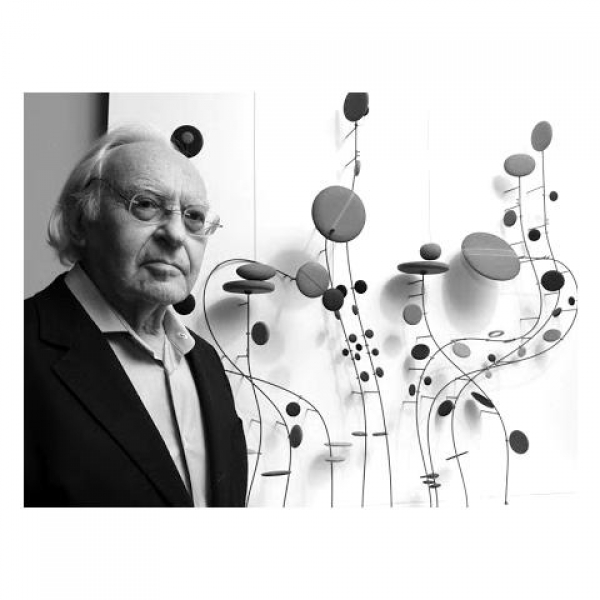Abraham Palatnik
Brasil - 1928

Abraham Palatnik (Natal, Rio Grande do Norte, 1928 - Rio de Janeiro, RJ, 2020).
Abraham Palatnik é figura central da arte cinética e óptica no Brasil. Seu interesse pelas possibilidades criativas das máquinas evoca a relação entre arte e tecnologia. O artista formou-se em engenharia, o que contribuiu para que desenvolvesse investigações técnicas focadas na experimentação com o movimento e a luz, realizando proposições baseadas no fenômeno visual que tornaram seu trabalho conhecido ao longo de sete décadas de produção. Destacou-se no cenário artístico a partir da criação de seu primeiro Aparelho Cinecromático (1949), peça em que reinventa a prática da pintura por meio do movimento coreografado de lâmpadas de diferentes voltagens em distintas velocidades e direções que criam imagens caleidoscópicas. Exibida na 1ª Bienal de São Paulo (1951), essa instalação de luz recebeu Menção Honrosa do júri internacional por sua originalidade.
As séries de progressões e relevos que iniciou posteriormente, feitas em materiais diversos (como madeira, cartão duplex ou acrílico), apresentam efeitos ópticos e cinéticos criados a partir de um meticuloso processo manual. O resultado são composições abstratas marcadas por um padrão rítmico que remete ao movimento de ondas irregulares. Embora a série W tenha incorporado o corte a laser feito por uma empresa especializada, Palatnik continua construindo e pintando artesanalmente cada peça até hoje, a fim de compor os quadros finais.
Abraham Palatnik nasceu em Natal, Brasil, em 1928, e faleceu no Rio de Janeiro, Brasil, em 2020. Participou de diversas exposições no Brasil e no exterior, incluindo oito edições da Bienal de São Paulo, Brasil (1951-1969), e a 32ª La Biennale di Venezia, Itália (1964). Recentemente, realizou a retrospectiva Abraham Palatnik - A Reinvenção da Pintura, com itinerância por importantes instituições no Brasil como: Centro Cultural Banco do Brasil (CCBB-RJ) (2017), Rio de Janeiro; Fundação Iberê Camargo (FIC) (2015), Porto Alegre; Museu Oscar Niemeyer (MON) (2014), Curitiba; Museu de Arte Moderna de São Paulo (MAM-SP) (2014), São Paulo; e Centro Cultural Banco do Brasil (CCBB-DF) (2013), Brasília. Principais coletivas recentes incluem: The Other Trans-Atlantic: Kinetic & Op Art in Central & Eastern Europe and Latin America 1950s - 1970s, no Sesc Pinheiros (2018), em São Paulo, Brasil, no Garage Museum of Contemporary Art (2018), em Moscou, Rússia, e no Museum of Modern Art in Warsaw (2017), em Varsóvia, Polônia; Delirious: Art at the Limits of Reason, 1950 - 1980, no Metropolitan Museum of Art (2018), em Nova York, Estados Unidos; e Kinesthesia: Latin American Kinetic Art 1954-1969, no Palm Springs Art Museum (PSAM) (2017), em Palm Springs, Estados Unidos. Possui obras em importantes coleções institucionais como: Museu de Arte Moderna do Rio de Janeiro (MAM-Rio), Rio de Janeiro, Brasil; Royal Museums of Fine Arts of Belgium, Bruxelas, Bélgica; Adolpho Leirner Collection of Brazilian Constructive Art, Museum of Fine Arts Houston (MFAH), Houston, EUA; e Museum of Modern Art (MoMA), Nova York, EUA.
_____
Abraham Palatnik is an iconic figure in the optical and kinetic art movements of Brazil - a pioneer in his long-standing interest for exploring the creative possibilities embedded in crossings of art and technology. Having studied engineering, the artist became interested in investigating mechanic uses of light and movement. In 1949, he rose to prominence with the creation of his first Aparelho Cinecromático [Kinechromatic Device] effectively reinventing the idea of a painting by using different voltage bulbs moving at different speeds and directions to create caleidoscopic images. The piece was shown at the 1st Bienal de São Paulo (1951) and received an Honorable Mention from the International Jury for its’ originality.
Abraham Palatnik subsequently initiated his work with reliefs, coined Progressive reliefs, which he made out of various materials (such as wood, duplex cardboard and acrylic), manually cut and intercalated to create a sense of rhythmic undulation. Apart from the series W, which has come to incorporate the use of laser-cutting, Palatnik continues to construct and paint every piece by hand, making each work a token of his craftmanship.
Abraham Palatnik was born in Natal, Brazil, in 1928. He died in Rio de Janeiro, Brazil, in 2020. He has participated in many exhibitions in Brazil and internationally, including eight editions of the Bienal de São Paulo (1951-1969) and the 32nd Biennale di Venezia, Italy (1964). Recently, a major retrospective titled Abraham Palatnik – A Reinvenção da Pintura [Abraham Palatnik – The Reinvention of Painting], was featured in several Brazilian institutions including: Centro Cultural Banco do Brasil Rio de Janeiro (CCBB-RJ), Rio de Janeiro, 2017; Fundação Iberê Camargo (FIC), Porto Alegre, 2015; Museu Oscar Niemeyer (MON), Curitiba, 2014; Museu de Arte Moderna de São Paulo (MAM-SP), São Paulo, 2014; and Centro Cultural Banco do Brasil Brasília (CCBB-DF), Brasília/DF, 2013. Main recent group exhibitions include: The Other Trans-Atlantic: Kinetic & Op Art in Central & Eastern Europe and Latin America 1950s - 1970s, with itinerancy at Sesc Pinheiros (2018), in São Paulo, Brazil, Garage Museum of Contemporary Art (2018), in Moscow, Russia, and at Museum of Modern Art in Warsaw (2017), in Warsaw, Poland; Delirious: Art at the Limits of Reason, 1950 - 1980, at the Metropolitan Museum of Art (2018), in New York, USA; and Kinesthesia: Latin American Kinetic Art 1954-1969, at Palm Springs Art Museum (PSAM) (2017), in Palm Springs, USA. His works are part of major permanent museum collections such as: Museu de Arte Moderna do Rio de Janeiro (MAM-Rio), Rio de Janeiro, Brazil; Royal Museums of Fine Arts of Belgium, Brussels, Belgium; Adolpho Leirner Collection of Brazilian Constructive Art, Museum of Fine Arts Houston (MFAH), Houston, USA; and Museum of Modern Art (MoMA), New York, USA.